Lithgow, New South Wales
Lithgow is a town in the Central Tablelands of New South Wales, Australia and is the administrative centre of the City of Lithgow local government area. It is located in a mountain valley named Lithgow's Valley by John Oxley in honour of William Lithgow, the first Auditor-General of New South Wales.
| Lithgow New South Wales | |||||||||
|---|---|---|---|---|---|---|---|---|---|
Lithgow_dusk_1989.jpg.webp) Lithgow at dusk | |||||||||
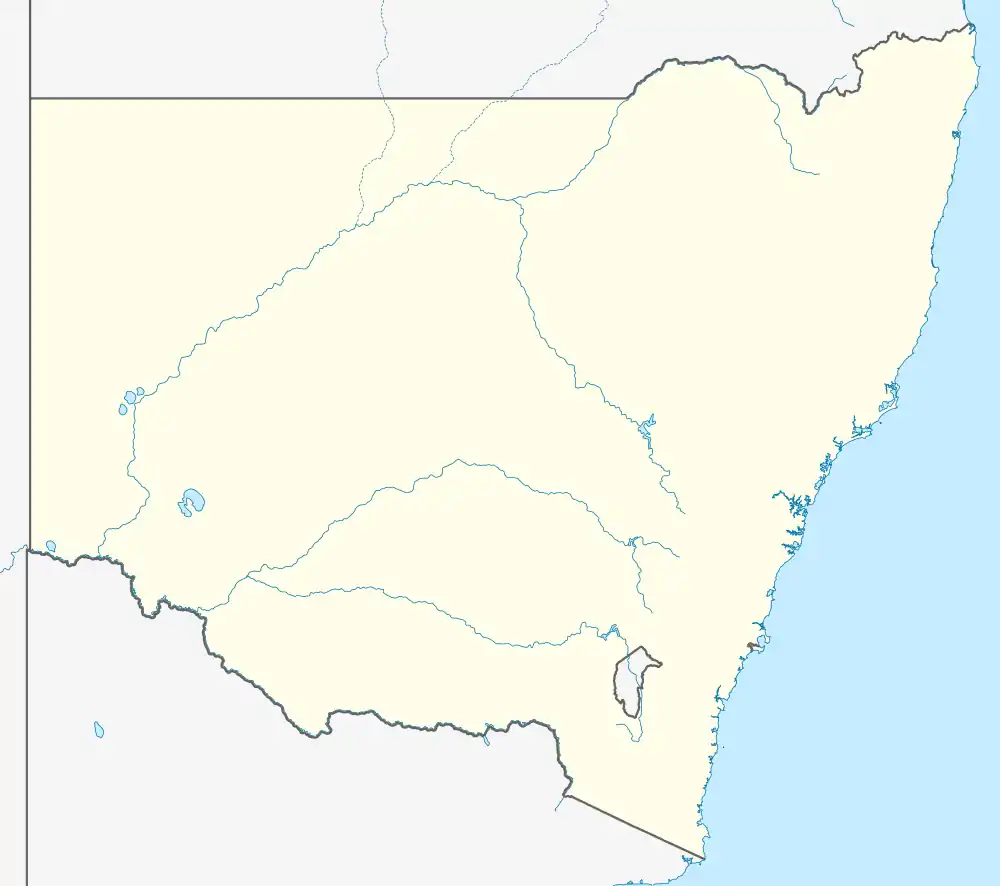 Lithgow | |||||||||
| Coordinates | 33°29′S 150°09′E | ||||||||
| Population | 12,973 (2018)[1] | ||||||||
| Established | 1870s | ||||||||
| Postcode(s) | 2790 | ||||||||
| Elevation | 950 m (3,117 ft)[2] | ||||||||
| Location | 150 km (93 mi) from Sydney | ||||||||
| LGA(s) | City of Lithgow | ||||||||
| County | Cook | ||||||||
| Parish | Lett | ||||||||
| State electorate(s) | Bathurst | ||||||||
| Federal Division(s) | Calare | ||||||||
| |||||||||
Lithgow is on the Great Western Highway, about 150 km (93 mi) or two hours drive west of Sydney,[3] or via the old mountain route, Bells Line of Road, from Windsor. At June 2018 Lithgow had an estimated urban population of 12,973.[1] Lithgow is surrounded by a varied landscape which includes national parks, one of which, the Blue Mountains National Park, is a World Heritage Area. The Wollemi National Park is home to the Jurassic-age tree the Wollemi Pine, which was found growing in a remote canyon in the park.[4]
Location
The city sits on the western edge of the sandstone country of the Blue Mountains and is usually considered the first true country town west of Sydney. Immediate surrounding areas include the old mining hamlet of Vale of Clywydd and Oakey Park, a famous iron and steel village, of which fiery night scenes have been depicted in many paintings, as well as large areas of bush and state forest. The next city to the West is Bathurst, 60 km (37 mi) away.
Lithgow is in the NSW State electorate of Bathurst, while federally it is part of electorate of Calare. Lithgow benefits from being the western terminus for the electric section of the Main Western railway line from Sydney, and of NSW TrainLink's Blue Mountains Line electric services. Lithgow is home to the iconic zig-zag railway.
History
The mountainous terrain of the Blue Mountains and the expense of building long tunnels required the construction of The Great Zig Zag railway between 1866 and 1869. The line was opened as far as Bowenfels, just to the west, in 1869, but Lithgow station was not opened until 1877. Although it was superseded in 1910 by more modern engineering methods, including ten tunnels, parts of the Zig Zag have been developed into a popular tourist attraction.[5] Following a period of industrialisation in the late 1860s and 1870s, the town of Lithgow boomed during the 1880s, and it was incorporated as a borough in 1889.[6]
The town is the centre of a coal mining district and there is one coal-powered power station nearby. It is the site of Australia's first commercially viable steel mill,[7] the ruins of which are open for inspection at "Blast Furnace Park". Due to the abundance of coal and relative proximity to Sydney, in the areas surrounding Lithgow are two of the largest power stations in NSW, the Mount Piper and Wallerawang power stations. Both are operated by Energy Australia NSW. The (now demolished) Lithgow Power Station was in use from 1928 to 1964.
Heritage listings
Lithgow has a number of heritage-listed sites, including the following listed on the New South Wales State Heritage Register:
- Bent Street: Lithgow Valley Colliery and Pottery Site[8]
- Brewery Lane: Lithgow Zig Zag[9]
- Gas Works Lane: Lithgow Coal Stage Signal Box[10]
- Inch Street: Lithgow Blast Furnace[11]
- 70 Inch Street: Eskbank House[12]
- Jenolan Caves Road: McKanes Falls Bridge[13]
- Main West Line 156.334 km, James Street: Lithgow Underbridge[14]
- Main Western railway: Eskbank railway station, New South Wales[15]
- Main Western railway: Ten Tunnels Deviation[16]
- Railway Parade: Lithgow railway station[17]
- Top Points Zig Zag railway: Cooerwull railway footbridge[18]
In addition, the following sites were listed on the (now defunct) Register of the National Estate:[19]
- Former Station Master's Residence (now Caddie's Restaurant), a sandstone cottage designed by John Clifton and built in 1869
- Eskbank House, Bennett Street, built by Thomas Brown in 1842
- Lithgow Valley Pottery Site Kiln, 1875 to 1908
- Lithgow Court House, corner Bridge and Mort Streets, a brick building in the Arts and Crafts style
- La Salle Cottage (formerly Cooerwull Academy), Rabaul Street, a stone building in the Victorian Gothic Revival style, built circa 1882
- Methven, Lidsdale Road, a sandstone house built by Andrew Brown in the 1870s
- Lithgow Small Arms Factory
Lithgow was also the location of an alleged assassination attempt on the life of Queen Elizabeth II in 1970.[20]
Climate
Lithgow features a subtropical highland climate (Köppen climate classification Cfb) with warm summers, cool to cold winters and generally steady precipitation year-round. Despite its location on highlands, Lithgow manages to have 90.3 clear days annually. Lithgow is one of the few Australian cities to see snow. One major event was the late season snowfall in October 2014, where 20 centimetres of snow fell.[21][22]
| Climate data for Lithgow (Birdwood St) | |||||||||||||
|---|---|---|---|---|---|---|---|---|---|---|---|---|---|
| Month | Jan | Feb | Mar | Apr | May | Jun | Jul | Aug | Sep | Oct | Nov | Dec | Year |
| Record high °C (°F) | 37.8 (100.0) |
38.4 (101.1) |
35.1 (95.2) |
30.8 (87.4) |
23.9 (75.0) |
19.5 (67.1) |
19.8 (67.6) |
22.5 (72.5) |
27.6 (81.7) |
33.1 (91.6) |
37.2 (99.0) |
36.8 (98.2) |
38.4 (101.1) |
| Average high °C (°F) | 25.5 (77.9) |
24.7 (76.5) |
22.4 (72.3) |
18.4 (65.1) |
14.3 (57.7) |
11.1 (52.0) |
10.4 (50.7) |
12.0 (53.6) |
15.4 (59.7) |
18.7 (65.7) |
21.5 (70.7) |
24.5 (76.1) |
18.2 (64.8) |
| Average low °C (°F) | 11.9 (53.4) |
12.1 (53.8) |
10.1 (50.2) |
6.7 (44.1) |
3.9 (39.0) |
1.8 (35.2) |
0.7 (33.3) |
1.3 (34.3) |
3.4 (38.1) |
6.0 (42.8) |
8.1 (46.6) |
10.4 (50.7) |
6.4 (43.5) |
| Record low °C (°F) | 2.8 (37.0) |
3.5 (38.3) |
0.0 (32.0) |
−4.0 (24.8) |
−6.1 (21.0) |
−7.0 (19.4) |
−8.0 (17.6) |
−8.0 (17.6) |
−5.0 (23.0) |
−2.3 (27.9) |
−1.7 (28.9) |
0.6 (33.1) |
−8.0 (17.6) |
| Average precipitation mm (inches) | 94.3 (3.71) |
83.8 (3.30) |
83.8 (3.30) |
62.7 (2.47) |
63.0 (2.48) |
67.3 (2.65) |
67.6 (2.66) |
63.4 (2.50) |
58.9 (2.32) |
67.7 (2.67) |
70.0 (2.76) |
76.1 (3.00) |
858.5 (33.80) |
| Average rainy days | 8.3 | 7.6 | 8.4 | 7.0 | 7.6 | 8.8 | 8.4 | 8.3 | 7.9 | 8.2 | 7.7 | 7.6 | 95.8 |
| Average afternoon relative humidity (%) | 54 | 58 | 60 | 59 | 66 | 67 | 66 | 56 | 54 | 51 | 53 | 50 | 58 |
| Source: [2] | |||||||||||||
Iron and steel industry
In 1848, iron smelting began in Mittagong, Australia. It proved unprofitable for the remainder of the 19th century. This situation remained until the early 20th century when no iron ore was being smelted. The only iron being cast was by William Sandford in Lithgow. His works were bought by G. & C. Hoskins in 1907, who had previously been making iron pipes in Sydney. The Lithgow works acquired a reputation for industrial disputes.
Tourist attractions
Lithgow is adjacent to a number of national parks and other attractions. Places to visit include the Zig Zag Railway, Glow Worm Tunnel, Newnes in the Wolgan Valley and Glen Davis in the Capertee Valley, the second largest canyon in the world.[23]
Other attractions include the Hartley Historic Site, Lithgow Small Arms Factory Museum, State Mine Heritage Park and the Eskbank House Museum. Lithgow is also close to Jenolan Caves, which are a World Heritage Area and lie to the south of Lithgow.[24]
The most popular tourist event in Lithgow is Ironfest (Lithgow), an annual cultural heritage event that attracts over 10,000 visitors.[25] Ironfest hosts the annual St George's Day Jousting Tournament which involves contestants from all around the world. The festival also features a colonial battle re-enactment, called the 'Battle of Lithgow' which involves over 120 participants, kitted out in fully authentic 19th century apparel, and involving cavalry, infantry and artillery. As well as these two historical re-enactment events Ironfest includes historical & auto displays, blacksmith demonstrations, art exhibitions, workshops and demonstrations, as well as live music and performances.
The Lithgow Greyhound Racing Club was established in 1928 [26][27] and its Saturday race meetings are also a popular tourist attraction. The annual feature event is the Lithgow Golden Muzzle held every December, which is sponsored by the Lithgow Workers Club.
Media
Electronic media in Lithgow is represented by commercial radio stations 2LT and Move FM operated by Midwest Radio Network, public broadcasters ABC and SBS, and commercial networks Prime7, WIN and Southern Cross Nine, 7TWO, 7mate, GEM, GO!, One HD and Eleven.
The Lithgow Mercury is a newspaper published tri-weekly in the town.
Notable residents
- Ean Griffiths, rapper that goes by the name of Top Dawg and is known for his hit song 'Cripwalk on you haterz" [28]
- Leon Morris - (1914-2006) Theologian and New Testament Scholar.
- Craig Bellamy - rugby league coach for the Melbourne Storm.
- Andrew Brown – the first European settler of the Lithgow Valley and a prominent industrialist and philanthropist.[29]
- Cardinal Edward Clancy AC (1923-2014) – the seventh Roman Catholic Archbishop of Sydney, Australia (1983 to 2001) was born in Lithgow.[30]
- Joseph Cook, (1860-1947) English Australian politician, resident of Lithgow and member for Hartley, and Parramatta. Sixth Prime Minister of Australia.
- John Doyle AM – a comedian of the duo Roy and HG, was born in Lithgow.[31]
- Wayde Egan - rugby league player for the Penrith Panthers.
- Roy Heffernan - Professional Wrestler, Tag Team Champions The Fabulous Kangaroos, Mr Australia was born in Lithgow 1925.
- Nancy Hill, Australian basketball player
- Charles Hoskins - an industrialist significant in the development of the iron and steel industry, lived at the former home of William Sandford, from 1908 to 1912.
- Marjorie Jackson-Nelson AC CVO MBE DStJ – a former athlete and Olympic gold medalist ("The Lithgow Flash") and later, Governor of South Australia, was raised in Lithgow.[32]
- Nina Eva Vida Jones (1882–1966) – a socialite and motor racing driver, married to John Alexander Stammers Jones (1870-1933), brewer of Lithgow.[33]
- Laurie Oakes – journalist, was educated at Lithgow High School, being dux in 1961.[34]
- David Palmer – a champion squash player, was born in Lithgow.[35]
- Marty Roebuck – a former Australian rugby union Wallabies fullback, was born in Lithgow.[36]
- William Sandford (1841–1932) - industrialist and pioneer of the iron and steel industry, lived at 'Eskroy Park', now part of the clubhouse of the Lithgow Golf Club, from 1890 to 1908.
- William John Truscott (1886-1966) - Footballer for the East Fremantle Football Club from 1913 to 1927.[37]
Gallery
 Shops on Main Street
Shops on Main Street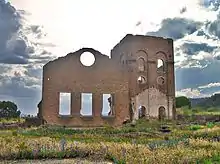 Blast Furnace Park
Blast Furnace ParkSt_Helens_Lithgow.jpg.webp) St Helens, Lithgow
St Helens, Lithgow Methven, Lithgow
Methven, LithgowCaddies_Restaurant_Lithgow.jpg.webp) Caddies Restaurant
Caddies Restaurant Eskbank House
Eskbank House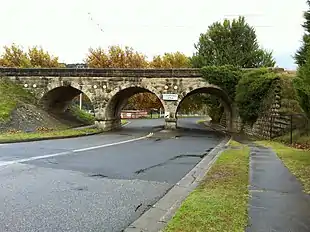 James St railway bridge
James St railway bridge Lithgow station platform
Lithgow station platform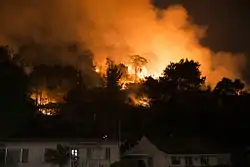 Houses threatened by 2013 bushfires
Houses threatened by 2013 bushfires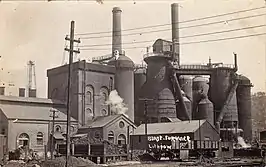 Blast Furnace at Lithgow (early C20th prior to 1928).
Blast Furnace at Lithgow (early C20th prior to 1928).
See also
References
- "3218.0 – Regional Population Growth, Australia, 2017-18: Population Estimates by Significant Urban Area, 2008 to 2018". Australian Bureau of Statistics. Australian Bureau of Statistics. 27 March 2019. Retrieved 25 October 2019. Estimated resident population, 30 June 2018.
- "Climate statistics for Lithgow (Birdwood St)". Climate statistics for Australian locations. Bureau of Meteorology. Retrieved 18 November 2011.
- Robinson's Road Atlas of Australia, Edition 8 (Lansdowne Press) 1983, Map 204
- "Wollemi National Park: Visitor Info". NSW National Parks and Wildlife Service: Visit a Park. NSW National Parks and Wildlife Service. Retrieved 10 November 2016.
- Bozier, Rolfe (ed.). "Main Western Line". NSWrail.net. Retrieved 29 November 2006.
- Cremin, Aedeen (1989). "The Growth of an Industrial Valley: Lithgow, New South Wales" (PDF). Australian Historical Archaeology. Sydney, New South Wales: Australian Society for Historical Archaeology. 7: 38. OCLC 742063057.
- Grunbach, A (September 2000). "An Episode in our Troubled Steel Industry". Australian Railway Historical Society Bulletin: 323–331.
- "Lithgow Valley Colliery & Pottery Site". New South Wales State Heritage Register. Office of Environment and Heritage. H00078. Retrieved 18 May 2018.
- "Great Zig Zag Railway and Reserves". New South Wales State Heritage Register. Office of Environment and Heritage. H00542. Retrieved 18 May 2018.
- "Lithgow Coal Stage Signal Box". New South Wales State Heritage Register. Office of Environment and Heritage. H01832. Retrieved 18 May 2018.
- "Lithgow Blast Furnace". New South Wales State Heritage Register. Office of Environment and Heritage. H00548. Retrieved 18 May 2018.
- "Eskbank House and Moveable Collections". New South Wales State Heritage Register. Office of Environment and Heritage. H02008. Retrieved 18 February 2020.
- "McKanes Falls Bridge". New South Wales State Heritage Register. Office of Environment and Heritage. H01473. Retrieved 18 May 2018.
- "Lithgow (James St) Underbridge". New South Wales State Heritage Register. Office of Environment and Heritage. H01831. Retrieved 18 May 2018.
- "Eskbank Railway Station group". New South Wales State Heritage Register. Office of Environment and Heritage. H01138. Retrieved 18 May 2018.
- "Great Zig Zag Railway deviation tunnels". New South Wales State Heritage Register. Office of Environment and Heritage. H01037. Retrieved 18 May 2018.
- "Lithgow Railway Station Group and Residence". New South Wales State Heritage Register. Office of Environment and Heritage. H01833. Retrieved 18 May 2018.
- "Cooerwull Railway footbridge". New South Wales State Heritage Register. Office of Environment and Heritage. H01115. Retrieved 18 May 2018.
- The Heritage of Australia, Macmillan Company, 1981, pp.2/264-265
- Malkin, Bonnie; Pierce, Andrew (27 January 2009). "Queen and Prince Philip were 'victims' of Australian assassination attempt". The Daily Telegraph. London. Retrieved 25 August 2009.
- Hart, Chloe; Woodburn, Joanna (16 October 2014). "Power still out and clean up continues day after Lithgow snow storm". ABC News. Retrieved 18 February 2016.
- Nageshwar, Pranesh; Paterson, Ian (15 October 2014). "Snow falls in Blackheath in springtime as Sydney's wild weather continues". Daily Telegraph. Retrieved 18 February 2016.
- "Capertee Valley". Lithgow Visitor Information Centre. Archived from the original on 13 July 2011. Retrieved 20 November 2011.
- "Lithgow". Visit NSW. Retrieved 11 June 2013.
- Come for the knight life
- 1928 Lithgow Greyhounds
- "Lithgow Greyhound Racing Club". Retrieved 4 September 2019.
- Michael Hunt. "A Guide to Aussie Hip-Hop". ToneDeaf. Retrieved 14 May 2018.
- "Andrew Brown". Lithgow Tourism. Auzziebiz. 2009. Retrieved 18 May 2012.
- Kerry Myers (3 August 2014). "A faithful son of the church: former Sydney Archbishop Edward Clancy dies". Smh.com.au. Retrieved 3 August 2014.
- Doyle, John (9 July 2006). "The Songlines Conversations". Big Ideas (transcript). Interviewed by Gregg Borschmann. ABC Radio National. Retrieved 18 May 2012.
- Jackson Nelson, Marjorie (31 May 2004). "GNT History". George Negus Tonight (transcript). Interviewed by George Negus. ABC1. Retrieved 21 October 2013.
- K. A. Johnson (1983). Jones, Nina Eva Vida (1882–1966). Australian Dictionary of Biography. 9. Australian Dictionary of Biography, National Centre of Biography, Australian National University. Retrieved 18 May 2014.
- Williams, Brett (December 2009). "To live and breathe politics" (PDF). Police Journal. Police Association of South Australia: 26–27, 47. Retrieved 18 May 2012.
- "David Troy Palmer - Bio". David Palmer Biography. Team Palmer. 2005. Retrieved 18 May 2012.
- "Marty Roebuck player profile". Scrum.com. ESPN EMEA Ltd. Retrieved 18 May 2012.
- Lee, Jack. Truscott, William John (1886–1966). Canberra: National Centre of Biography, Australian National University.
External links
| Wikimedia Commons has media related to Lithgow, New South Wales. |
| Wikisource has the text of the 1911 Encyclopædia Britannica article Lithgow. |
 Lithgow travel guide from Wikivoyage
Lithgow travel guide from Wikivoyage- Lithgow Tourism Information
- VISITNSW.com - Lithgow
- Map of Lithgow, New South Wales on OpenStreetMap